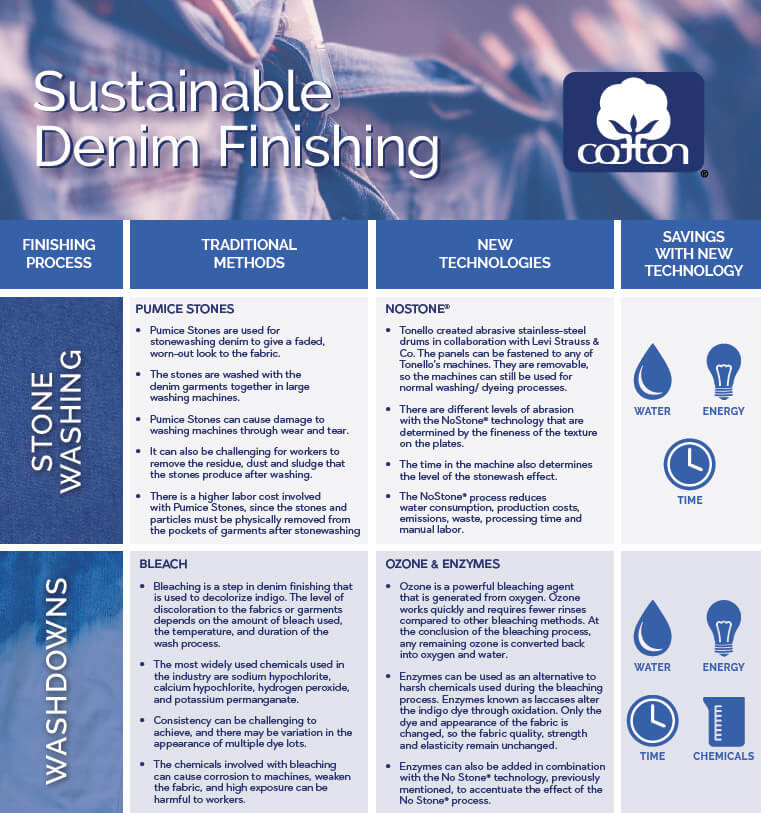Denim Sustainability
Sustainable Denim Finishing
As supply chain needs continue to change, both brands and consumers alike are looking for more sustainable options without sacrificing the look and feel that consumers love about their favorite pair of jeans.
It is possible to achieve the same designs and overall look of denim while saving water, energy, time, and/or chemicals throughout the process.
This Sustainable Denim Finishing chart explains the differences between traditional and new technologies for stonewashing, washdown effects, whisker effects, and sanding.
Stone Washing
Pumice Stones
Traditional Method
Pumice stones are used for stonewashing denim to give a faded, worn-out look to the fabric. The stones are washed with denim garments together in large washing machines.
Pumice stones can cause damage to washing machines through wear and tear. It can also be challenging for workers to remove the residue, dust, and sludge that the stones produce after washing. There is also a higher labor cost involved with pumice stones since the stones and particles must be physically removed from the pockets of garments after stonewashing.
NoStone®
New Tecnology
Tonello created abrasive stainless-steel drums in collaboration with Levi Strauss & Co. The panels can be fastened to any of Tonello’s machines. They are removable, so the machines can still be used for normal washing/dyeing processes.
There are different levels of abrasion with the NoStone® technology that are determined by the fineness of the texture on the plates. The time in the machine also determines the level of the stonewash effect.
The NoStone® process reduces water consumption, production costs, emissions, waste, processing time, and manual labor.
Washdowns
Bleach
Traditional Method
Bleaching is a step in denim finishing that is used to decolorize indigo. The level of discoloration to the fabrics or garments depends on the amount of bleach used, the temperature, and the duration of the wash process.
The most widely used chemicals used in the industry are sodium hypochlorite, calcium hypochlorite, hydrogen peroxide, and potassium permanganate. The chemicals involved with bleaching can cause corrosion to machines, weaken the fabric, and high exposure can be harmful to workers.
Consistency can be challenging to achieve, and there may be variations in the appearance of multiple dye lots.
Ozone & Enzymes
New Technology
Ozone is a powerful bleaching agent that is generated from oxygen. Ozone works quickly and requires fewer rinses compared to other bleaching methods. At the conclusion of the bleaching process, any remaining ozone is converted back into oxygen and water.
Enzymes can be used as an alternative to the harsh chemicals used during the bleaching process. Enzymes known as laccases alter the indigo dye through oxidation. Only the dye and appearance of the fabric are changed, so the fabric quality, strength, and elasticity remain unchanged.
Enzymes can also be added in combination with the NoStone® technology, previously mentioned, to accentuate the effect of the NoStone® process.
Whisker Effect
Potassium Permanganate (PP)
Traditional Method
Potassium Permanganate (PP) is an oxidizing agent that is used for local bleaching/finishing on denim. PP spray is used on jeans to lighten a specific area and create whisker effects on denim.
PP spray can have harmful effects on workers by irritating and burning the skin and eyes when workers come into direct contact with it. Without safe ventilation systems and equipment, factory workers can be at risk for short-term and long-term health issues when working with this chemical.
Laser
New Technology
Lasers can mimic the finishing effects of Potassium Permanganate.
Available from both Tonello and Jeanologia, the laser machine can create vintage effects, whiskers, patterns, patches, and even intentional holes and tears in a garment.
The laser technology uses less water, chemicals, and energy to create a wide variety of denim looks. Laser boosters can be applied to the fabric in order to intensify the effect of the laser to mimic heavier bleaching applications.
Potassium Permanganate Alternatives
Other chemical systems have been developed which do not release manganese, a non-biodegradable heavy metal, into the environment.
These potassium permanganate alternatives are often non-toxic or significantly less toxic to the environment than potassium permanganate and provide a very similar bleaching effect as potassium permanganate.
Sanding
Manual Sanding & Sandblasting
Traditional Method
Manual sanding is used to create faded areas by physically scraping the surface of denim garments with a variety of tools. Manual sanding can also be used to create rips and other worn effects in localized areas. This process is labor-intensive and inconsistent.
Sandblasting uses compressed air to forcefully spray sand at the garments. Sandblasting is extremely hazardous to workers, which has led many organizations to ban the technique.
Laser
New Technology
Laser, as mentioned above, can also be used to mimic hand sanding and sandblasting. The laser can be pre-programmed with patterns that can mimic exactly the desired look achieved through manual sanding and sandblasting with significantly less labor and physical hazards.
Denim Finishing Technologies for a More Sustainable Future
This denim-focused webinar covers:
- New technologies for denim finishing that offer lower environmental impacts
- Laser options for creating traditional effects such as whiskers, sanding, washdowns, and more
- Bleach-down alternatives
- Inventions that can change the future of denim finishing
Download Denim Finishing Technologies for a More Sustainable Future.
Webinar originally played 10/13/22.
Sustainable Solutions for Denim Processing
With new approaches in denim dyeing, finishing, and processing, there are now attainable and sustainable solutions available that benefit the producer, the consumer, and the planet.
During this webinar, our team of experts focused on several sustainable technologies designed for processing denim from dyeing through garment finishing. They also explored both chemical and mechanical solutions to producing sustainable cotton denim fabric and featured some of the latest in inspirational denim fabric development from Cotton Incorporated’s FABRICAST™ Collection.
Looking for denim inspiration to add to your product line? Our denim FABRICAST™ collection covers fashion effects including laser etching and garment dyeing, novelty yarns, technologies for performance, and earth-friendly offerings.
NoStone® is a registered trademark of Tonello.



